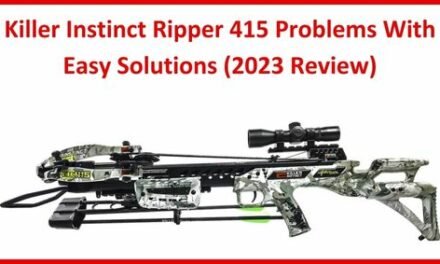Hawke scope problems include rheostat failure, loose parallax turrets, chromatic aberration, internal faults, warranty disputes, decreased zooming ability, poor image quality, and difficulty holding zero.
Some users have reported problems with Hawke scopes, while others have had positive experiences with no issues.
It is important to note that these problems are not universal and can often be addressed through maintenance, adjustments, and repairs.
Hawke Scope Problems
Let’s discuss Potential causes and solutions for Hawke scope problems:
Rheostat Failure
When it comes to rheostat problems with Hawke scopes, it seems that some users have reported issues with the rheostat not working or malfunctioning. The rheostat is a feature on some Hawke scopes that allows for adjustment of the reticle brightness or illumination.
Here are a few possible solutions or considerations for rheostat problems with Hawke scopes:
Check the battery:
If the rheostat is not working or the reticle illumination is not functioning properly, it could be due to a weak or dead battery. Check the battery compartment and ensure that the battery is properly inserted, with the correct polarity.
Clean the contacts:
Over time, dirt or debris may accumulate on the contacts between the battery and the rheostat. Use a clean cloth or a cotton swab dipped in rubbing alcohol to gently clean the contacts. This can help improve the electrical connection and restore functionality.
Replace the battery:
If cleaning the contacts does not resolve the issue, try replacing the battery with a fresh one. It’s possible that the existing battery is no longer providing enough power for the rheostat to function properly.
Parallax Problem
Hawke scope parallax problems can include issues such as excessive parallax error, difficulty adjusting parallax, or inconsistent parallax performance.
Parallax error occurs when the reticle appears to shift or move in relation to the target when the shooter’s eye position changes. This can affect accuracy and target acquisition.
To address parallax problems with a Hawke scope, you can try the following steps:
Adjust the parallax:
Hawke scopes often have a parallax adjustment feature, typically located on the side or turret of the scope. Rotate the adjustment knob or ring to match the distance to your target. Start with the parallax adjustment set to the average range you’ll be shooting, then fine-tune it for each specific distance. Follow the instructions in the scope’s manual for proper adjustment.
Check for loose components:
Ensure that all components, including the parallax adjustment turret, are securely tightened. Loose components can cause inconsistent parallax performance. Use the appropriate tools to tighten any screws or knobs, being careful not to overtighten.
Clean the lens:
Dust or debris on the lens can affect the clarity and accuracy of the scope, including parallax performance. Use a lens cleaning solution and a microfiber cloth to gently clean the lens surfaces. Follow the manufacturer’s recommendations for cleaning.
Chromatic Aberration
Chromatic aberration refers to the color fringing or distortion that can occur in optics, resulting in a loss of image quality.
Chromatic aberration control:
Some Hawke scopes, such as the Frontier APO series, are designed to offer excellent chromatic aberration control. This means that they aim to minimize or reduce the color fringing effect and provide a clear and high-quality image.
Mixed reports:
While some users have mentioned that chromatic aberration is not a significant problem with Hawke scopes, others have reported experiencing color fringing to varying degrees. It’s important to note that individual experiences and expectations may differ.
Other factors:
Chromatic aberration can be influenced by various factors, including optical design, lens quality, and the user’s expectations. It’s worth considering that chromatic aberration can be present to some extent in most optics, and it may vary depending on the specific scope model and its price range.
Personal preferences:
Some users may have a higher tolerance for chromatic aberration, while others may find it more bothersome. Personal preferences and the specific application of the scope (e.g., birdwatching, target shooting, etc.) can also play a role in how noticeable or problematic chromatic aberration may be perceived.
Hawke Scope Zoom Problem
Here is the information related to Hawke scope zoom problems and potential solutions:
Blurry crosshairs at high magnification:
Some users have reported blurry crosshairs at high magnification on Hawke scopes. This could be due to the high magnification causing image quality issues.
Raised scope with fixed power:
One solution mentioned for a zoom problem is to purchase a scope with a raised or fixed power design. This could potentially eliminate any zoom-related issues.
Troubleshooting blurry scope:
If you are experiencing a blurry scope, it could be due to factors such as improper focus, improper eye relief, or other issues. Troubleshooting steps may include adjusting the focus, checking eye relief, or seeking professional assistance if needed.
Hawke Scope Alignment Issues
Reports of alignment issues
Some users have reported alignment issues with their Hawke scopes. These issues can manifest as problems with focus and clarity, as well as difficulties in achieving proper accuracy. In some cases, users have mentioned that the alignment was significantly off, resulting in a misaligned sight picture.
Possible causes and solutions
There can be several factors that contribute to alignment issues with Hawke scopes. These may include manufacturing defects, improper installation, or damage during use. It is recommended to carefully follow the manufacturer’s instructions for mounting and zeroing the scope to minimize the chances of alignment problems.
If you encounter alignment issues with your Hawke scope, here are some potential steps to consider:
Check mounting and tightening:
Ensure that the scope is securely mounted to the rifle and that all screws and fasteners are tightened properly. Loose or improperly tightened mounts can lead to misalignment.
Re-zero the scope:
If you suspect an alignment issue, it may be necessary to re-zero the scope. Follow the proper procedures for adjusting windage and elevation to align the reticle with the point of impact.
Contact Hawke:
If the alignment issue persists, it is advisable to contact Hawke directly for assistance. They may be able to provide guidance on troubleshooting steps or suggest sending the scope for inspection or repair.
Hawke Scope Not Holding Zero
To address the issue of a Hawke scope not holding zero, here are a few potential steps you can take:
Check mounting and tightening:
Ensure that the scope is securely mounted to the rifle and that all screws and fasteners are tightened properly. Loose or improperly tightened mounts can lead to a loss of zero.
Inspect the scope:
Check for any visible damage or defects on the scope itself. If you notice any issues, it may be necessary to contact Hawke for support or consider a warranty claim if applicable.
Consider recoil management:
Excessive recoil can cause scopes to lose zero. If you are experiencing this issue, you may want to explore options such as using recoil management devices or seeking professional advice on reducing recoil.
Hawke Scope Accuracy Issues
To address potential accuracy issues with a Hawke scope, here are a few steps you can consider:
Check scope mounting:
Ensure that the scope is securely mounted and properly aligned with the firearm. Loose or misaligned mounts can affect accuracy.
Inspect the scope:
Check for any visible damage or defects on the scope itself, such as lens scratches or misalignment. If you notice any issues, it may be necessary to contact Hawke for support or consider a warranty claim if applicable.
Consider ammunition and shooting technique:
Inaccurate shooting can sometimes be attributed to factors other than the scope itself, such as ammunition inconsistencies or improper shooting technique. Ensure that you are using high-quality ammunition and practicing proper shooting fundamentals.
More About Hawke Scopes
Hawke offers a wide range of scope models for various applications. Here are some of the Hawke scope models.
Hawke Frontier
The Frontier series features scopes with Hawke’s H7 optics, offering high definition viewing, color control, and phase correction. Examples include the Frontier 30 1-6×24 L4A Dot and Frontier 30 SF 5-30×56 LR Dot.
Hawke Nature-Trek
The Nature-Trek series includes spotting scopes that offer exceptional optical quality. An example is the Nature-Trek 9-27×56 Spotting Scope, known for its compact size and high magnification.
Hawke Sidewinder
The Sidewinder series is designed for tactical shooting with features like illuminated reticles and sidewheel parallax adjustment.
Hawke Airmax
The Airmax series is known for its suitability for airgun use, offering features such as adjustable objective lenses and AMX reticles.
Hawke Vantage
The Vantage series includes scopes with a range of features and options for different shooting applications, including illuminated reticles and adjustable objective lenses.

Frequently Asked Questions
Where are Hawke scopes manufactured?
Hawke scopes are manufactured in China, but the company is headquartered in the United Kingdom.
What is the optical quality of Hawke scopes?
Hawke scopes are generally well-regarded for their optics, with features like multi-coated lenses and good light transmission.
Are Hawke scopes waterproof and fogproof?
Many Hawke scopes are nitrogen-filled and O-ring sealed for waterproof and fogproof performance.
What reticle options are available in Hawke scopes?
Hawke scopes offer a variety of reticle options, including duplex, Mil Dot, and specialty reticles for specific shooting applications.
What is the warranty coverage for Hawke scopes?
Hawke offers different warranty periods depending on the specific model, but they generally have a limited lifetime warranty.
Are Hawke scopes compatible with different mounting systems?
Hawke scopes typically have a 1-inch tube diameter, although some models may have a 30mm tube, which affects compatibility with different mounting systems.










